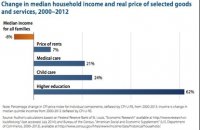Are Democrats Out of Data Analysts?
A Democratic think tank publishes a chart that would get laughed out of Econ 101.
For Exhibit A, you can’t do much better than the Center for American Progress report that the group’s president, Neera Tanden, cites in Klein’s article. Tanden says that Democrats need to think more creatively about “the vise of stagnating wages and rising costs” (in Klein’s words). “We did this report,” she says,
Klein includes a chart from the report in his piece showing that “median income for all families” fell 8 percent from 2000 to 2012 while rent, medical care, child care, and higher education have grown more expensive.

Except this “vise” is invented. (The report actually indicates that the median income of Tanden’s double-earner-two-kid family rose slightly, but we’ll let that slide and focus on the median for all families shown in the chart.) There’s an amateur-hour mistake in this chart, which is the basis for the CAP report, which in turn is the sort of analysis driving the thinking of CAP’s (and therefore Democrats’) economic agenda. The chart shows that median household income has declined by 8 percent — but that’s the change after adjusting for the increase in the cost of living. It makes no sense to point out that income has decreased by 8 percent while the cost of living has increased, because the increased cost of living is already included in that 8 percent figure. Tanden’s lament about a family getting hit from both sides is based on double counting.
If you do not adjust for the increase in the cost of living and instead look at nominal income, it rose by 23 percent. In other words, while middle-class income rose by 23 percent, the cost of living rose by 33 percent, so in the end real median income was lower.
A Democratic think tank publishes a chart that would get laughed out of Econ 101.
For Exhibit A, you can’t do much better than the Center for American Progress report that the group’s president, Neera Tanden, cites in Klein’s article. Tanden says that Democrats need to think more creatively about “the vise of stagnating wages and rising costs” (in Klein’s words). “We did this report,” she says,
that showed that if you look at the prototypical family — double earner, two kids — their wages have stood still since roughly 2000, but their cost of living has gone up by about $10,000 because of things like child care and health care. We have had tax policy that has ameliorated that challenge by about $5,000. But they still have $5,000 less than they did before. So you can see why they’re getting kind of irritated.
Klein includes a chart from the report in his piece showing that “median income for all families” fell 8 percent from 2000 to 2012 while rent, medical care, child care, and higher education have grown more expensive.

Except this “vise” is invented. (The report actually indicates that the median income of Tanden’s double-earner-two-kid family rose slightly, but we’ll let that slide and focus on the median for all families shown in the chart.) There’s an amateur-hour mistake in this chart, which is the basis for the CAP report, which in turn is the sort of analysis driving the thinking of CAP’s (and therefore Democrats’) economic agenda. The chart shows that median household income has declined by 8 percent — but that’s the change after adjusting for the increase in the cost of living. It makes no sense to point out that income has decreased by 8 percent while the cost of living has increased, because the increased cost of living is already included in that 8 percent figure. Tanden’s lament about a family getting hit from both sides is based on double counting.
If you do not adjust for the increase in the cost of living and instead look at nominal income, it rose by 23 percent. In other words, while middle-class income rose by 23 percent, the cost of living rose by 33 percent, so in the end real median income was lower.

